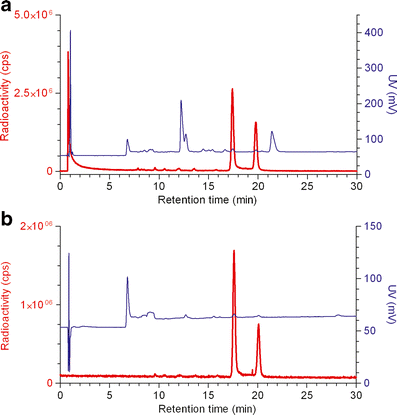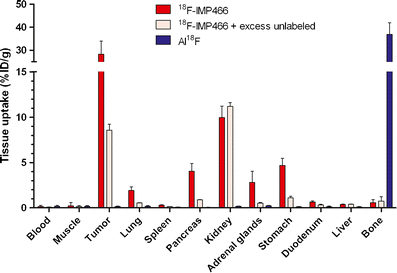Optimized labeling of NOTA-conjugated octreotide with F-18
- PMID: 22009690
- PMCID: PMC3296034
- DOI: 10.1007/s13277-011-0250-x
Optimized labeling of NOTA-conjugated octreotide with F-18
Abstract
We recently reported a facile method based on the chelation of [(18)F]aluminum fluoride (Al(18)F) by NOTA (1,4,7-triazacyclononane-1,4,7-triacetic acid). Here, we present a further optimization of the (18)F labeling of NOTA-octreotide (IMP466). Octreotide was conjugated with the NOTA chelate and was labeled with (18)F in a two-step, one-pot method. The labeling procedure was optimized with regard to the labeling buffer, ionic strength, peptide concentration, and temperature. Radiochemical yield, specific activity, in vitro stability, and receptor affinity were determined. Biodistribution of (18)F-IMP466 was studied in AR42J tumor-bearing mice. In addition, microPET/CT images were acquired. IMP466 was labeled with Al(18)F in a single step with 97% yield in the presence of 80% (v/v) acetonitrile or ethanol. The labeled product was purified by HPLC to remove unlabeled peptide and unbound Al(18)F. The radiolabeling, including purification, was performed for 45 min. Specific activities of 48,000 GBq/mmol could be obtained. (18)F-IMP466 showed a high tumor uptake and excellent tumor-to-blood ratios at 2 h post-injection. In addition, the low bone uptake indicated that the Al(18)F-NOTA complex was stable in vivo. PET/CT scans revealed excellent tumor delineation and specific accumulation in the tumor. Uptake in receptor-negative organs was low. NOTA-octreotide could be labeled with (18)F in quantitative yields using a rapid two-step, one-pot, method. The compound was stable in vivo and showed rapid accretion in SSTR(2)-receptor-expressing AR42J tumors in nude mice. This method can be used to label other NOTA-conjugated compounds such as RGD peptides, GRPR-binding peptides, and Affibody molecules with (18)F.
Figures




Similar articles
-
A novel facile method of labeling octreotide with (18)F-fluorine.J Nucl Med. 2010 Mar;51(3):454-61. doi: 10.2967/jnumed.109.066902. Epub 2010 Feb 11. J Nucl Med. 2010. PMID: 20150268 Free PMC article.
-
In vitro and in vivo evaluation of a (18)F-labeled high affinity NOTA conjugated bombesin antagonist as a PET ligand for GRPR-targeted tumor imaging.PLoS One. 2013 Dec 3;8(12):e81932. doi: 10.1371/journal.pone.0081932. eCollection 2013. PLoS One. 2013. PMID: 24312607 Free PMC article.
-
PET of tumors expressing gastrin-releasing peptide receptor with an 18F-labeled bombesin analog.J Nucl Med. 2012 Jun;53(6):947-52. doi: 10.2967/jnumed.111.100891. Epub 2012 May 8. J Nucl Med. 2012. PMID: 22570329
-
Imaging of human epidermal growth factor receptor type 2 expression with 18F-labeled affibody molecule ZHER2:2395 in a mouse model for ovarian cancer.J Nucl Med. 2012 Jan;53(1):146-53. doi: 10.2967/jnumed.111.093047. Epub 2011 Dec 15. J Nucl Med. 2012. PMID: 22173842
-
Al(18) F labeling of peptides and proteins.J Labelled Comp Radiopharm. 2014 Apr;57(4):219-23. doi: 10.1002/jlcr.3161. Epub 2014 Jan 10. J Labelled Comp Radiopharm. 2014. PMID: 24408125 Review.
Cited by
-
18F-AlF-NOTA-octreotide PET/CT in the localization of tumor-induced osteomalacia: case series and literature review.Front Endocrinol (Lausanne). 2024 Jun 3;15:1400751. doi: 10.3389/fendo.2024.1400751. eCollection 2024. Front Endocrinol (Lausanne). 2024. PMID: 38887276 Free PMC article. Review.
-
Radiofluorination using aluminum-fluoride (Al18F).EJNMMI Res. 2013 May 8;3(1):36. doi: 10.1186/2191-219X-3-36. EJNMMI Res. 2013. PMID: 23651690 Free PMC article.
-
Somatostatin Receptor Targeted PET-CT and Its Role in the Management and Theranostics of Gastroenteropancreatic Neuroendocrine Neoplasms.Diagnostics (Basel). 2023 Jun 24;13(13):2154. doi: 10.3390/diagnostics13132154. Diagnostics (Basel). 2023. PMID: 37443548 Free PMC article. Review.
-
Highlight selection of radiochemistry and radiopharmacy developments by editorial board (January-June 2020).EJNMMI Radiopharm Chem. 2021 Jan 28;6(1):5. doi: 10.1186/s41181-020-00118-5. EJNMMI Radiopharm Chem. 2021. PMID: 33507426 Free PMC article. Review.
-
Introduction to this special issue on tumor targeting.Tumour Biol. 2012 Jun;33(3):571-2. doi: 10.1007/s13277-012-0390-7. Tumour Biol. 2012. PMID: 22492239 No abstract available.
References
-
- Poethko T, Schottelius M, Thumshirn G, Hersel U, Herz M, Henriksen G, Kessler H, Schwaiger M, Wester HJ. Two-step methodology for high-yield routine radiohalogenation of peptides: 18F-labeled RGD and octreotide analogs. J Nucl Med. 2004;45:892–902. - PubMed
Publication types
MeSH terms
Substances
Grants and funding
LinkOut - more resources
Full Text Sources
Other Literature Sources

